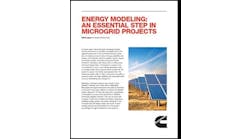Texas consumers could save $5.47 billion over ten years with distributed energy resources (DERs), but regulations must change to realize these benefits.
A study by Texas Advanced Energy Business Alliance (TAEBA) identified two ways DERs can reduce costs:
- Act as non-wires alternatives to avoid investment in tranmission and distribution ($2.45 billion over ten years)
- Decrease peak energy costs in the wholesale market which is worth $3.01 billion
Because much of the study is based on 2018 data, these savings estimates don’t incorporate the fact that prices for peaking energy last summer jumped as high as a whopping $9,000/MWh.
“Even though this report looked at the ERCOT (Electric Reliability Council of Texas) market specifically, it still is indicative of the value DERs bring in other markets as well,” said Suzanne Bertin, managing director, TAEBA.
“That’s money that is right on the bottom line in terms of what customers have to pay for electricity.”
Had last summer been included…
Josh Bode, owner, Demand Side Analytics and principal author of the study, said, “We analyzed five years to ensure a single year did not drive the results and started the study before the $9,ooo price spike. The underlying logic is the same, however. The $9000 energy prices were due to high net loads and shortage of recognized, dispatchable resources.”
Texas had a substantial amount of existing DER and flexible demand resources, but the wholesale market did not fully utilize those resources because they are not well-integrated. If they had used those resources, the peak prices would have been lower, he said.
The estimated savings from the report would have been higher if the $9,000 prices in 2019 were included in the analysis, he said.
The group’s goal, she said, is to increase transparency in the market and encourage non-wires alternatives. Customers are investing in DERs — solar, electric cars and batteries, for example. They need the opportunity to participate in markets either as individuals or as part of aggregations, she said.
A number of initiatives that could boost distributed energy resources are hobbling along in the state.
The Public Utility Commission of Texas (PUC) opened a project (48023) to begin looking at how the state can better integrate non-traditional technology into delivery services. One of the main issues focuses on whether utilities in this deregulated market can own technology such as storage.
The commission put that project on hold so the legislature could try to clarify the issue, said Bertin. A bill in the state Legislature, SB 1941, would have prohibited utilities from owning storage but would allow them to contract for those services and earn a return on the contracts. TAEBA supported that bill, but it never made it to the state House of Representatives.
TAEBA now wants the PUC to take another look at the issue and provide a more transparent planning process.
“This would provide more information to the competitive market identifying the most advantageous places for DERs on the system. The PUC could put in place processes that consider non-wires solutions as opposed to traditional infrastructure builds.”
The lieutenant governor has issued an interim charge to the Senate Committee on Business and Commerce to look at how customer demand for distributed sources is changing, and evaluate non-wires alternatives and barriers to DERs, including electric vehicles. “There’s a lot of interest on the part of legislative leadership to look at these issues,” she said.
One issue that’s been examined is connecting batteries at the distribution level. But ERCOT, the grid operator for most of Texas, has paused that effort, saying there are regulatory gaps that affect reliability.
System visibility needed
Like other grid operators, ERCOT is concerned about its lack of visibility into distribution-level assets and their affect on the bulk system. “We need to work out the details to make that work end to end,” said Bertin.
ERCOT issued a market notice to inform market participants of its proposals to ensure distribution-level generation resources are reliable.
“ERCOT has determined that these practices are necessary to mitigate reliability risks to the ERCOT System. These practices are relevant only to the limited subset of distribution-level generators that register as Generation Resources (i.e., those that participate in ancillary services and/or economic dispatch),” said ERCOT in the notice.
Learn more about distributed energy resources in ERCOT by downloading the free white paper: Capturing the Full Value of Renewable Energy for Business in ERCOT.
The regulatory gaps include rules governing outage coordination. Current rules don’t assign responsibility for providing the status of distributed energy resources.
For example, ERCOT would like visibility between distributed energy resources and the ERCOT transmission system. Otherwise, there may be a reliability risk, ERCOT said.
“A lot of this could be worked out at the ERCOT stakeholder process,” said Bertin. “This is where operational details are determined.”
Aggregating distributed energy resources
She noted that a number of parties have worked on regulations for aggregating resources and offering them into ERCOT markets. But for various reasons, these efforts have not yet come to fruition.
While efforts to change rules and regulations at the state, PUC and ERCOT level are slowly moving forward, utility customers are losing money that could be made by taking advantage of distributed energy resources.
“The fact that this past summer we started seeing $9,000/MWh prices in energy markets for peak energy should provide incentives in the market to address some of these issues,” said Bertin.
Track news about distributed energy resources. Subscribe to the free Microgrid Knowledge newsletter.








